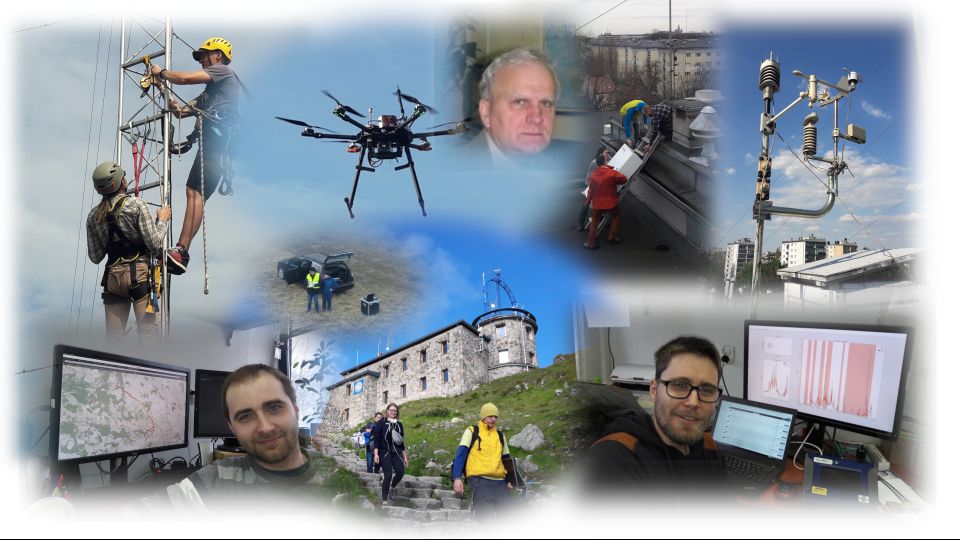Welcome to Environmental Physics Group website

 Zespół Fizyki Środowiska
Zespół Fizyki Środowiska 
Scientific activities of the Environmental Physics Group (EPG) are centered around problems associated with the use of natural variability of isotopic composition of light elements (hydrogen, oxygen, carbon, nitrogen) in environmental research, in particular related to cycling of water and carbon in the environment. Both stable and radioactive isotopes are being employed. In addition, methodological developments focusing on various analytical methods associated with determination of natural radioactivity levels in various matrices (rocks, soil, water , air, biological material) are pursued.
Environmental Physics Group is also active in the field of atmospheric physics, with emphasis on research of atmospheric trace gases contributing to greenhouse effect. Systematic measurements of atmospheric concentrations of major greenhouse gases (carbon dioxide, methane, nitrous oxide) are performed on remote mountain sites (Kasprowy Wierch, Tatra Mountains) as well as in urban environment (Krakow). The measurements are performed using gas chromatography and Cavity Ring-Down Spectroscopy techniques.
The Group conducts research on the concentration of natural and artificial alpha-, gamma- and beta-emitting radionuclides in the natural environment (geological samples, soil, plants, food) and around mining facilities and natural gas transport network, using the alpha-, gamma- ray spectrometry and liquid scintillation counting (LSC) methods. Research is conducted on the concentration of radon (222Rn) in natural gas and lead (210Pb) in solid waste generated by natural gas industry. In addition, measurements of the concentration of natural alpha and beta-radionuclides (238U, 234U, 228Ra, 226Ra, 224Ra, 222Rn, 210Pb, 210Po) are carried out in water samples.
Environmental Physics Group is a leading centre in Poland in applications of isotope tracer methods in hydrology. Laboratories of EPG perform complex investigations of isotopic composition of surface and groundwater systems (concentration of tritium and radiocarbon, concentration of uranium, radium and thorium isotopes, stable isotope ratios of hydrogen, oxygen and carbon). Environmental isotope data play an important role in addressing the following issues: origin and age of groundwater, (ii) transport processes in unsaturated zone, (iii) diagnostics of water hazard in mines, (iv) groundwater vulnerability to pollution, and (v) development and management of mineral water resources.
Environmental Physics Group Department of Applied Nuclear Physics (DANP) Faculty of Physics and Applied Computer Science (FPACS) offers cooperation in the measurement and interpretation of the isotopic composition of surface and groundwater. Group perform also analysis of the isotopic composition of water at the request of domestic and foreign institutions. Environmental Physics Group is the leading center of applications of isotopic methods in hydrogeology. The team offers also comprehensive analyzes of levels of natural radioactivity of various types of environmental materials as well as analysis of the concentration and composition of trace gases in the atmosphere.
Environmental Physics Group DANP FPACS offers:
1. Comprehensive analyzes of the isotopic composition of surface and groundwater, including:
* tritium concentration
* isotopic ratios 2H/1H, 18O/16O
* carbon concentration 14C isotopic ratio 13C/12C in dissolved carbonates
Contact: This email address is being protected from spambots. You need JavaScript enabled to view it., This email address is being protected from spambots. You need JavaScript enabled to view it.
2. Analysis of the isotope composition of carbon and oxygen in carbonates.
Contact: This email address is being protected from spambots. You need JavaScript enabled to view it.
3. Dating of carbonate or organic materials using the 14C carbon method 14C.
Contact: This email address is being protected from spambots. You need JavaScript enabled to view it.
4. Dating of young sediments using the lead method 210Pb.
Contact: This email address is being protected from spambots. You need JavaScript enabled to view it.
5. Measurement of the amount of natural K-40, Ra-226 and Th-228 radioactive isotopes in building materials before they are placed on the market.
Contact: This email address is being protected from spambots. You need JavaScript enabled to view it.
6. Measurement of concentration of natural and artificial gamma-radiation nuclides, by gamma spectrometry in environmental samples (geological samples, soil, plants, food). In particular, accurate measurements of Pb-210, including self-absorption in the sample.
Contact: This email address is being protected from spambots. You need JavaScript enabled to view it.
7. Analyzes the concentration and isotopic composition of trace gases in the atmosphere (CO2, CH4, SF6, N2O). Determination of the trace and isotopic composition of trace gases (CO2, CH4, N2O) from soil.
Contact: This email address is being protected from spambots. You need JavaScript enabled to view it., This email address is being protected from spambots. You need JavaScript enabled to view it.
8. Measurement of concentrations of natural alpha- and beta-radiated nuclides (238U, 234U, 228Ra, 226Ra, 224Ra, 222Rn, 210Pb, , 210Po) in water samples.
Contact: This email address is being protected from spambots. You need JavaScript enabled to view it.